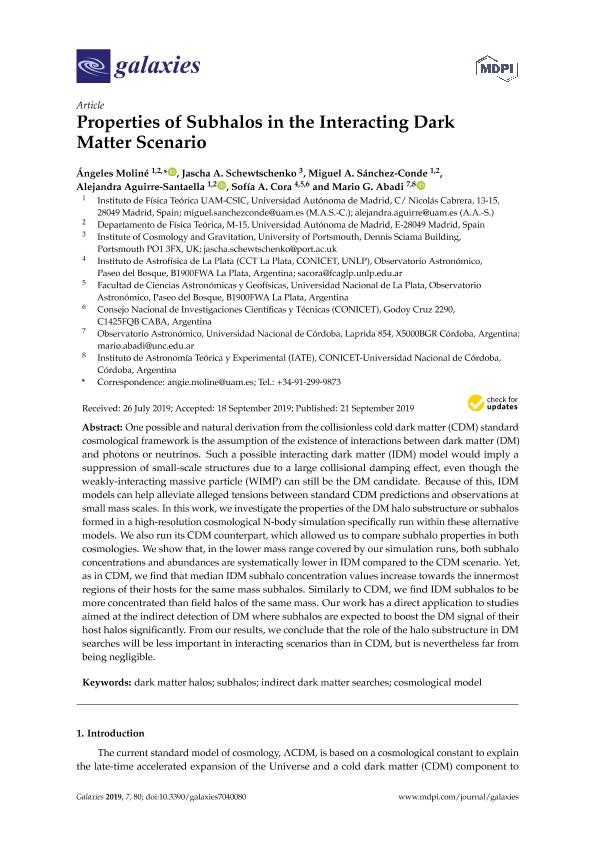Mostrar el registro sencillo del ítem
dc.contributor.author
Moliné, Ángeles

dc.contributor.author
Schewtschenko, Jascha A.
dc.contributor.author
Sánchez Conde, Miguel A.
dc.contributor.author
Aguirre Santaella, Alejandra
dc.contributor.author
Cora, Sofia Alejandra

dc.contributor.author
Abadi, Mario Gabriel

dc.date.available
2021-02-10T02:49:23Z
dc.date.issued
2019-09-21
dc.identifier.citation
Moliné, Ángeles; Schewtschenko, Jascha A.; Sánchez Conde, Miguel A.; Aguirre Santaella, Alejandra; Cora, Sofia Alejandra; et al.; Properties of subhalos in the interacting dark matter scenario; Multidisciplinary Digital Publishing Institute; Galaxies; 7; 4; 21-9-2019; 1-16
dc.identifier.issn
2075-4434
dc.identifier.uri
http://hdl.handle.net/11336/125256
dc.description.abstract
One possible and natural derivation fromthe collisionless cold dark matter (CDM) standard cosmological framework is the assumption of the existence of interactions between dark matter (DM) and photons or neutrinos. Such a possible interacting dark matter (IDM) model would imply a suppression of small-scale structures due to a large collisional damping effect, even though the weakly-interacting massive particle (WIMP) can still be the DM candidate. Because of this, IDM models can help alleviate alleged tensions between standard CDM predictions and observations at small mass scales. In this work, we investigate the properties of the DM halo substructure or subhalos formed in a high-resolution cosmological N-body simulation specifically run within these alternative models. We also run its CDM counterpart, which allowed us to compare subhalo properties in both cosmologies. We show that, in the lower mass range covered by our simulation runs, both subhalo concentrations and abundances are systematically lower in IDM compared to the CDM scenario. Yet, as in CDM, we find that median IDM subhalo concentration values increase towards the innermost regions of their hosts for the same mass subhalos. Similarly to CDM, we find IDM subhalos to be more concentrated than field halos of the same mass. Our work has a direct application to studies aimed at the indirect detection of DM where subhalos are expected to boost the DM signal of their host halos significantly. From our results, we conclude that the role of the halo substructure in DM searches will be less important in interacting scenarios than in CDM, but is nevertheless far from being negligible.
dc.format
application/pdf
dc.language.iso
eng
dc.publisher
Multidisciplinary Digital Publishing Institute
dc.rights
info:eu-repo/semantics/openAccess
dc.rights.uri
https://creativecommons.org/licenses/by-nc-sa/2.5/ar/
dc.subject
COSMOLOGICAL MODEL
dc.subject
DARK MATTER HALOS
dc.subject
INDIRECT DARK MATTER SEARCHES
dc.subject
SUBHALOS
dc.subject.classification
Astronomía

dc.subject.classification
Ciencias Físicas

dc.subject.classification
CIENCIAS NATURALES Y EXACTAS

dc.title
Properties of subhalos in the interacting dark matter scenario
dc.type
info:eu-repo/semantics/article
dc.type
info:ar-repo/semantics/artículo
dc.type
info:eu-repo/semantics/publishedVersion
dc.date.updated
2020-11-19T21:58:22Z
dc.journal.volume
7
dc.journal.number
4
dc.journal.pagination
1-16
dc.journal.pais
Suiza

dc.description.fil
Fil: Moliné, Ángeles. Universidad Autónoma de Madrid; España. Consejo Superior de Investigaciones Científicas; España
dc.description.fil
Fil: Schewtschenko, Jascha A.. University of Portsmouth; Reino Unido
dc.description.fil
Fil: Sánchez Conde, Miguel A.. Universidad Autónoma de Madrid; España
dc.description.fil
Fil: Aguirre Santaella, Alejandra. Universidad Autónoma de Madrid; España
dc.description.fil
Fil: Cora, Sofia Alejandra. Consejo Nacional de Investigaciones Científicas y Técnicas. Centro Científico Tecnológico Conicet - La Plata. Instituto de Astrofísica La Plata. Universidad Nacional de La Plata. Facultad de Ciencias Astronómicas y Geofísicas. Instituto de Astrofísica La Plata; Argentina
dc.description.fil
Fil: Abadi, Mario Gabriel. Consejo Nacional de Investigaciones Científicas y Técnicas. Centro Científico Tecnológico Conicet - Córdoba. Instituto de Astronomía Teórica y Experimental. Universidad Nacional de Córdoba. Observatorio Astronómico de Córdoba. Instituto de Astronomía Teórica y Experimental; Argentina
dc.journal.title
Galaxies
dc.relation.alternativeid
info:eu-repo/semantics/altIdentifier/url/https://www.mdpi.com/2075-4434/7/4/80
dc.relation.alternativeid
info:eu-repo/semantics/altIdentifier/doi/http://dx.doi.org/10.3390/galaxies7040080
Archivos asociados
